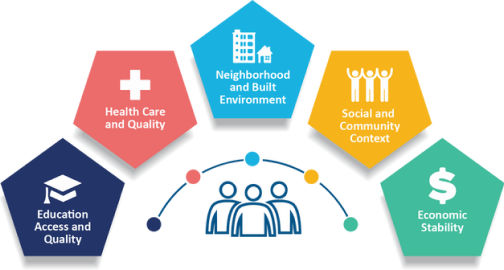
Health related needs are conditions in the environments in which people are born, live, learn, work, play, worship, and age that affect a wide range of health, functioning, and life outcomes and risks (Healthy People, 2030).
Health related needs can be grouped into 5 domains: Education Access and Quality, Health Care and Quality, Neighborhood and Built Environment, Social and Community Context, and Economic Stability. Click on each tab below to view health related need resources per Domain.
The Health Related Needs Resource Hub provides health centers (HCs) access to available screening tools, educational materials such as guides, fact sheets, infographics, videos and other resources related to the health related needs that affect people’s health, to assist staff efforts in screening, documenting, and addressing health related needs impacting the Migratory and Seasonal Agricultural Worker (MSAW) population. This Hub also features screening tools and resources shared and discussed with participant HCs from NCFH’s IAC Plus Learning Collaborative (IAC PLUS LC), a HRSA supported collaboration intended to increase knowledge about health related needs factors impacting the health care, access, and health status of the MSAW population.
The connection of Education to health and wellbeing.
The connection between people’s access to and understanding of health services and their own health.
The connection between where a person lives – housing, neighborhood, and environment – and their health and well-being.
The connection between characteristics of the contexts within which people live, learn, work, and play, and their health and wellbeing.
Screening for health related needs can help identify population needs and who may benefit from resources and efforts to improve health outcomes.
This list contains screening tools and other resources, screening tools are denoted with an (*) asterisk for easy identification.
NCFH has developed 3 tools to help health centers assess health related needs for MSAW populations and navigate health resources.
Association of Asian Pacific Community Health Organizations (AAPCHO), and Oregon Primary Care Association (OPCA) developed this screening tool as a national effort to help health centers and other providers collect the data needed to better understand and act on their patients’ health related needs.
AMERICAN HOSPITAL ASSOCIATION
Aunt Bertha (Findhelp): https://www.findhelp.org/
211: https://www.211.org/
AAFP Neighborhood Navigator: https://navigator.aafp.org/
Cap4Kids: https://cap4kids.org
Feeding America: https://www.feedingamerica.org
Supplemental Nutrition Assistance Program: https://www.fns.usda.gov/snap
Special Supplemental Nutrition Program for Women, Infants, and Children (WIC): https://www.fns.usda.gov/wic
Public Housing and Voucher Program: https://www.hud.gov/topics/rental_assistance
Benefit Finder questionnaire: https://www.benefits.gov/
1Degree: https://www.1degree.org/
NowPow: https://www.nowpow.com/